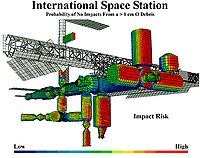
Photo from wikipedia
Risk assessment is a crucial process in the development of an oil field. Many tools and methods have been developed and applied in this area, such as reservoir simulation, surface… Click to show full abstract
Risk assessment is a crucial process in the development of an oil field. Many tools and methods have been developed and applied in this area, such as reservoir simulation, surface response methodology and emulators. The tool and methodology choices should link to the level of uncertainity and the type of uncertain parameters (continuous, discrete and stochastic attributes), aiming at reliable results with reduced computational time/cost. The main goal of this work is to apply the Response Surface Methodology (RSM) to build proxy models in order to substitute the reservoir simulation model of medium-fidelity yielding to speed up part of the risk analysis processes that demands a high computational effort. The model passes through statistical and cross-validation in order to be used in production prediction. These validations ensure that the model output resides within a previously established confidence interval. Uncertainty analysis is evaluated based on building risk curves and then the curves are compared with the simulation output, to evaluate the proxy model efficiency based on the Normalized Quadratic Deviation with Signal (NQDS). The proxy study involves the following steps: (1) Statistical design to perform a sensitivity analysis of the objective functions; (2) Statistical design to obtain the response surface; (3) Statistical validation through analysis of variance (ANOVA); (4) Consistency check of proxies with the simulator outputs; (5) Latin Hypercube Sampling (LHS) technique to generate equi-probable scenarios during a crossvalidation procedure; (6) Application, building the risk curves through the generated proxy models to assist the decision analysis and (7) Comparison with the curves generated by the simulation using 500 scenarios generated by the LHS. From the LHS tool, 500 equi-probable scenarios were generated to build the risk curves using the proxy model and then compared with those generated by the reservoir simulator. The NQDS indicator measures the distance among curves. If the value resides between the interval of -1 and +1 it means that the proxy is efficiently reproducing the simulator response within a previous defined tolerance (5% in this case). This template is provided to give authors a basic shell for preparing your manuscript for submittal to an SPE meeting or event. Styles have been included to give you a basic idea of how your finalized paper will look before it is published by SPE. All manuscripts submitted to SPE will be extracted from this template and tagged into an XML format; SPE’s standardized styles and fonts will be used when laying out the final manuscript. Links will be added to your manuscript for references, tables, and equations. Figures and tables should be placed directly after the first paragraph they are mentioned in. The content of your paper WILL NOT be changed.
Journal Title: Eurosurveillance
Year Published: 2017
Link to full text (if available)
Share on Social Media: Sign Up to like & get
recommendations!